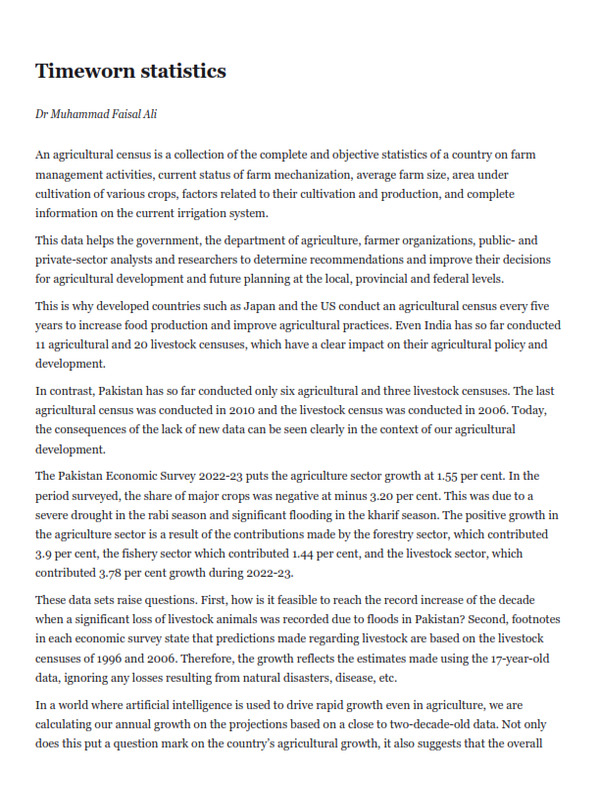Timeworn statistics
An agricultural census is a collection of the complete and objective statistics of a country on farm management activities, current status of farm mechanization, average farm size, area under cultivation of various crops, factors related to their cultivation and production, and complete information on the current irrigation system.
This data helps the government, the department of agriculture, farmer organizations, public- and private-sector analysts and researchers to determine recommendations and improve their decisions for agricultural development and future planning at the local, provincial and federal levels.
This is why developed countries such as Japan and the US conduct an agricultural census every five years to increase food production and improve agricultural practices. Even India has so far conducted 11 agricultural and 20 livestock censuses, which have a clear impact on their agricultural policy and development.
In contrast, Pakistan has so far conducted only six agricultural and three livestock censuses. The last agricultural census was conducted in 2010 and the livestock census was conducted in 2006. Today, the consequences of the lack of new data can be seen clearly in the context of our agricultural development.
The Pakistan Economic Survey 2022-23 puts the agriculture sector growth at 1.55 per cent. In the period surveyed, the share of major crops was negative at minus 3.20 per cent. This was due to a severe drought in the rabi season and significant flooding in the kharif season. The positive growth in the agriculture sector is a result of the contributions made by the forestry sector, which contributed 3.9 per cent, the fishery sector which contributed 1.44 per cent, and the livestock sector, which contributed 3.78 per cent growth during 2022-23.
These data sets raise questions. First, how is it feasible to reach the record increase of the decade when a significant loss of livestock animals was recorded due to floods in Pakistan? Second, footnotes in each economic survey state that predictions made regarding livestock are based on the livestock censuses of 1996 and 2006. Therefore, the growth reflects the estimates made using the 17-year-old data, ignoring any losses resulting from natural disasters, disease, etc.
In a world where artificial intelligence is used to drive rapid growth even in agriculture, we are calculating our annual growth on the projections based on a close to two-decade-old data. Not only does this put a question mark on the country’s agricultural growth, it also suggests that the overall growth figures are not completely correct; this misrepresentation will persist in the absence of new statistics or censuses.
Pakistan is an agricultural nation, and thus it is possible to anticipate undesirable results when all the planning is based on the data that is almost 13-year-old for agriculture and 17-year-old for livestock. The thinking that these data sets will help us revolutionize the agricultural sector is terrible. Policymakers are developing and recommending strategies to assist farmers but are unsure about the specific area that needs to be targeted.
According to the 2010 census, 89 per cent of farms had less than five ha of land, 47 per cent of Pakistan’s farmland and 55 per cent of its cultivated land were owned by this 89 percent of the farms. Understanding how this land distribution has altered over the past 13 years is absolutely crucial for future planning. Further, the older census also lacks information on the exigent effects of climate change, practical climatic adaptations for more resilient agriculture, and gradual understanding of the potential drawbacks or costs of adapting tactics and projects.
The livestock case is more worrisome, as we are utilizing projections from the 2006 census. We are unsure about the precise trend and pace of the livestock sector. Without taking into account the effects of special initiatives implemented over the past 17 years for the upgrading of this sector, the projections merely reflect an increase in the quantity of animals and the resulting increase in their proportion of the national income. The impact of all external factors like floods, disease attacks on animals, etc, which significantly affect the number and production of livestock and poultry animals is disregarded too. This is abysmal.
There are talks for an agriculture policy and strategy for Green Revolution 2.0. But, in the absence of new agricultural statistics and given the current sceptical growth figures, the need for a new agriculture and livestock census is a prerequisite to bring any revolution in the agriculture sector. There can be no revolution without a new census.
The Pakistani government and policymakers should conduct an agricultural and livestock census as soon as possible. This will better equip all stakeholders to address issues and take advantage of all possibilities to ensure the growth of sustainable agriculture.
A timely census should also be prioritized every five or 10 years, as it is crucial for research and development, resource allocation, policy formulation, monitoring, and evaluation, and above all to revolutionize the agricultural sector. If not, the country may merely fantasize about any green revolution using timeworn statistics.
The writer is a research fellow at the Pakistan Institute of Development Economics (PIDE). He tweets/posts @DrMFaisal_Ali




